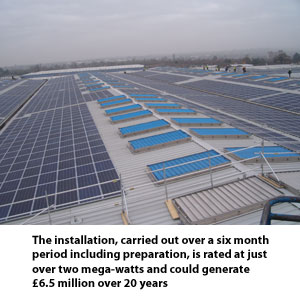 Mark Group has installed 8,000 solar panels on the roof of Wolseley UK’s National Distribution Centre (NDC) in Leamington Spa, capable of generating enough electricity each year to supply around 450 homes.
Mark Group has installed 8,000 solar panels on the roof of Wolseley UK’s National Distribution Centre (NDC) in Leamington Spa, capable of generating enough electricity each year to supply around 450 homes.
A roof area of 13,113m² – roughly the size of two football pitches – has been covered in 8020 JA Solar Polycrystalline panels, along with accompanying Fronius inverters, at Wolseley UK’s head office site.
The installation, carried out over a six-month period including preparation, is rated at just over two mega-watts and could generate £6.5 million over 20 years under the government’s Feed-in Tariff (FIT) for commercial buildings. Over a year, the system should generate more energy than is consumed at Wolseley UK’s National Distribution Centre, along with a surplus of around ten per cent.
Chris Roberts, head of solar at Mark Group, said: “The rise in energy prices and the levelling off of installation costs means that 2014 is a sweet spot for businesses installing solar PV.
“The government’s FIT continues to fall slowly, so now is the time to invest in solar to obtain the best payback.
“Wolseley’s investment in this installation should be completely repaid in around seven years, which means the NDC will receive free energy thereafter. Wolseley UK will also achieve carbon savings of around 1,280 tonnes per year, helping to improve the Leamington Spa site’s environmental performance, which is already rated by BREEAM as ‘very good’”.
Steve Ashmore, managing director, Wolseley UK, said: “As a business, we are committed to sustainable building. We opened the UK’s first commercial showcase for sustainable building products and construction methods, our Sustainable Building Center, in 2008. And we are continuing to lead the way by investing in the technology that we advocate.
“We are already seeing some fantastic environmental and cost savings from our PV installation and I hope that our success will inspire others to adopt green energy solutions, due to the significant results they can achieve.”
The installation incorporates various innovations and one such innovation is to channel some of the exhaust air from the inverters into the building’s heating systems to further reduce the building’s carbon emissions.
